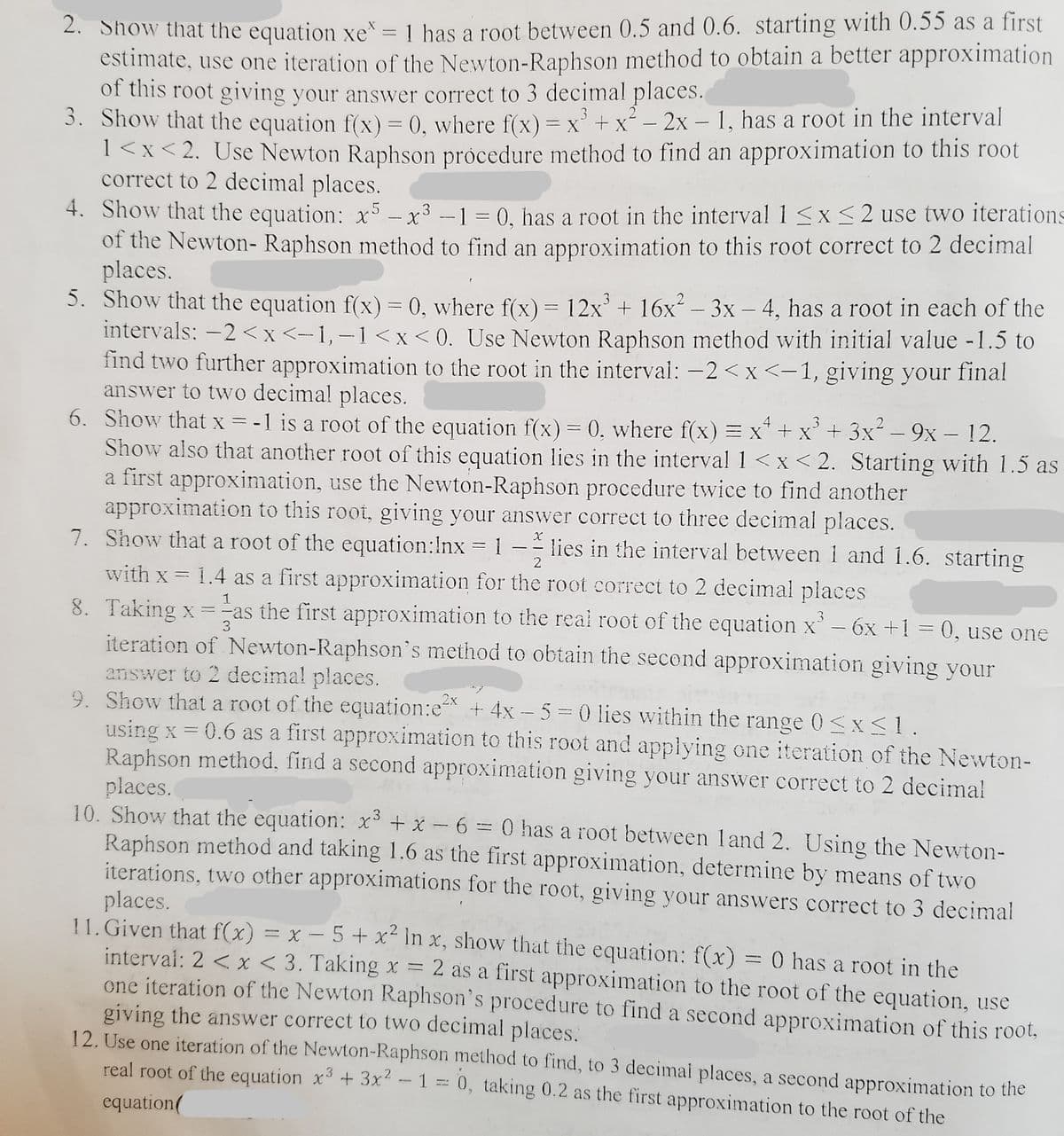Show that the equation xe= 1 has a root between 0.5 and 0.6. starting with 0.55 as a first estimate, use one iteration of the Newton-Raphson method to obtain a better approximation of this root giving your answer correct to 3 decimal places. Show that the equation f(x) = 0, where f(x) = x + x² – 2x – 1, has a root in the interval 1
Show that the equation xe= 1 has a root between 0.5 and 0.6. starting with 0.55 as a first estimate, use one iteration of the Newton-Raphson method to obtain a better approximation of this root giving your answer correct to 3 decimal places. Show that the equation f(x) = 0, where f(x) = x + x² – 2x – 1, has a root in the interval 1
Calculus: Early Transcendentals
8th Edition
ISBN:9781285741550
Author:James Stewart
Publisher:James Stewart
Chapter1: Functions And Models
Section: Chapter Questions
Problem 1RCC: (a) What is a function? What are its domain and range? (b) What is the graph of a function? (c) How...
Related questions
Concept explainers
Equations and Inequations
Equations and inequalities describe the relationship between two mathematical expressions.
Linear Functions
A linear function can just be a constant, or it can be the constant multiplied with the variable like x or y. If the variables are of the form, x2, x1/2 or y2 it is not linear. The exponent over the variables should always be 1.
Question
Solve Q2, 3, 4 explaining detailly each step

Transcribed Image Text:2. Show that the equation xe = 1 has a root between 0.5 and 0.6. starting with 0.55 as a first
estimate, use one iteration of the Newton-Raphson method to obtain a better approximation
of this root giving your answer correct to 3 decimal places.
3. Show that the equation f(x) = 0, where f(x) = x° + x² – 2x – 1, has a root in the interval
1<x<2. Use Newton Raphson pròcedure method to find an approximation to this root
correct to 2 decimal places.
%3D
4. Show that the equation: x5 - x³ -
of the Newton- Raphson method to find an approximation to this root correct to 2 decimal
places.
5. Show that the equation f(x) = 0, where f(x) = 12x + 16x – 3x – 4, has a root in each of the
intervals: -2 <x <-1, -1<x <0. Use Newton Raphson method with initial value -1.5 to
find two further approximation to the root in the interval: -2 < x <-1, giving your final
answer to two decimal places.
6. Show that x = -1 is a root of the equation f(x)= 0. where f(x) = x* + x' + 3x² – 9x – 12.
Show also that another root of this equation lies in the interval 1<x<2. Starting with 1.5 as
a first approximation, use the Newton-Raphson procedure twice to find another
approximation to this root, giving your answver correct to three decimal places.
7. Show that a root of the equation:Inx = 1
1 = 0, has a root in the interval 1<x<2 use two iterations
-
lies in the interval between i and 1.6. starting
- -
2
with x = 1.4 as a first approximation for the root correct to 2 decimal places
8. Taking x =-as the first approximation to the real root of the equation x'– 6x +1 = 0, use one
iteration of Newton-Raphson's method to obtain the second approximation giving your
answer to 2 decimal places.
9. Show that a root of the equation:e + 4x - 5 = 0 lies within the range 0 <x<1.
using x = 0.6 as a first approximation to this root and applying one iteration of the Newton-
Raphson method, find a second approximation giving your answer correct to 2 decimal
places.
10. Show that the equation: x³ + x - 6 = 0 has a root between land 2. Using the Newton-
Raphson method and taking 1.6 as the first approximation, determine by means of two
iterations, two other approximations for the root, giving your answers correct to 3 decimal
places.
11. Given that f(x) = x – 5+ x² In x, show that the equation: f(x) = 0 has a root in the
interval: 2 < x < 3. Taking x =
one iteration of the Newton Raphson's procedure to find a second approximation of this root,
giving the answer correct to two decimal places.
12. Use one iteration of the Newton-Raphson method to find, to 3 decimai places, a second approximation to the
real root of the equation x + 3x -1 = 0, taking 0.2 as the first approximation to the root of the
1
3
2x
2 as a first approximation to the root of the equation, use
.3
equation(
Expert Solution
This question has been solved!
Explore an expertly crafted, step-by-step solution for a thorough understanding of key concepts.
Step by step
Solved in 4 steps with 5 images

Knowledge Booster
Learn more about
Need a deep-dive on the concept behind this application? Look no further. Learn more about this topic, calculus and related others by exploring similar questions and additional content below.Recommended textbooks for you

Calculus: Early Transcendentals
Calculus
ISBN:
9781285741550
Author:
James Stewart
Publisher:
Cengage Learning

Thomas' Calculus (14th Edition)
Calculus
ISBN:
9780134438986
Author:
Joel R. Hass, Christopher E. Heil, Maurice D. Weir
Publisher:
PEARSON

Calculus: Early Transcendentals (3rd Edition)
Calculus
ISBN:
9780134763644
Author:
William L. Briggs, Lyle Cochran, Bernard Gillett, Eric Schulz
Publisher:
PEARSON

Calculus: Early Transcendentals
Calculus
ISBN:
9781285741550
Author:
James Stewart
Publisher:
Cengage Learning

Thomas' Calculus (14th Edition)
Calculus
ISBN:
9780134438986
Author:
Joel R. Hass, Christopher E. Heil, Maurice D. Weir
Publisher:
PEARSON

Calculus: Early Transcendentals (3rd Edition)
Calculus
ISBN:
9780134763644
Author:
William L. Briggs, Lyle Cochran, Bernard Gillett, Eric Schulz
Publisher:
PEARSON

Calculus: Early Transcendentals
Calculus
ISBN:
9781319050740
Author:
Jon Rogawski, Colin Adams, Robert Franzosa
Publisher:
W. H. Freeman


Calculus: Early Transcendental Functions
Calculus
ISBN:
9781337552516
Author:
Ron Larson, Bruce H. Edwards
Publisher:
Cengage Learning